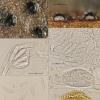
11-01-2016 14:19
 Björn Wergen
Björn Wergen
Hi friends,I have recently found an unkwon species

10-01-2016 23:48
Thorben HülsewigHi there,today i found on (i think Ceratellopsis,

09-01-2016 19:19
 Blasco Rafael
Blasco Rafael
Hola, tengo esta muestra recogida sobre rama de Pi

10-01-2016 17:32
 Jakob Schneller
Jakob Schneller
Dear collegues I had problems identifying this sm

10-01-2016 14:04
 Yannick Mourgues
Yannick Mourgues
En compagnie d'un Gibberella sp. cet asco immérg�

09-01-2016 22:40
 Lothar Krieglsteiner
Lothar Krieglsteiner
Today we found this discomycete in Stuttgart, on a

05-01-2016 19:50
 Bernard CLESSE
Bernard CLESSE
Bonsoir à tous,Trouvé récemment sur tige pourri
Oletheriostrigula? Leptosphaerulina?
Björn Wergen,
11-01-2016 14:19
 Hi friends,
Hi friends,I have recently found an unkwon species growing on bark of Ulmus glabra, of which I think it could belong to Oletheriostrigula or Leptosphaerulina (?). I have also recognized similarities to Arthopyrenia, but I did not manage to find it in literature. Maybe someone else knows where it belongs to ;)
Spores are 19-30x5-7µm, with 5-7 septations, rarely with a single longitudinal septation, breaking into two part spores when fully mature, with distinct gel coat. Asci bitunicate, with a distinct apical apparatus (ring like), pyriforme / obpyriforme, thickwalled, 60x25µm. Pseudoparaphyses very short celled, ~ 3µm, very numerous. Pseudothecia wall about 15-20µm thick, near ostiolus with scleroplectenchymatous parts, else pseudoparenchymatous of globose, 2-3µm cells. Periphyses not seen.
Leptosphaerulina species mostly occur on leaves of various deciduous plants, and builds globose fruitbodies instead of hermisphaeric as here shown.
Oletheriostrigula is very similar, but is found on Cyperaceae regarding to Enrique's recolt (Cladium mariscus).
thanks for any hints,
regards,
björn

